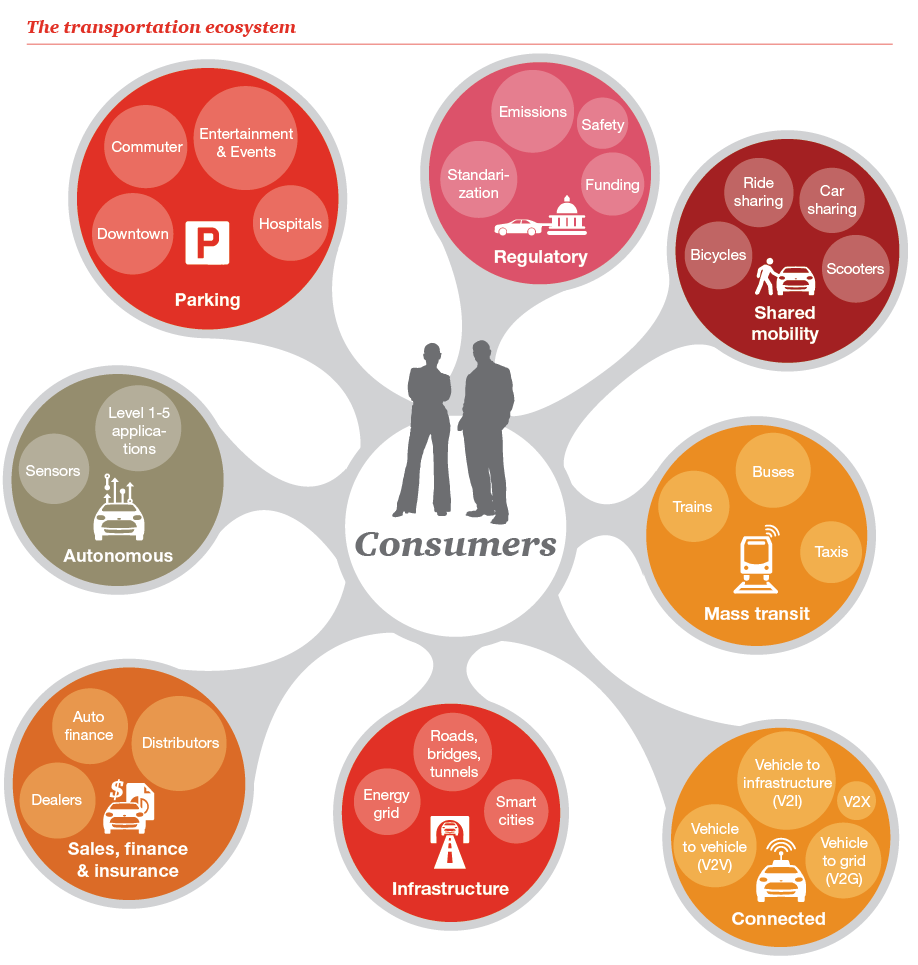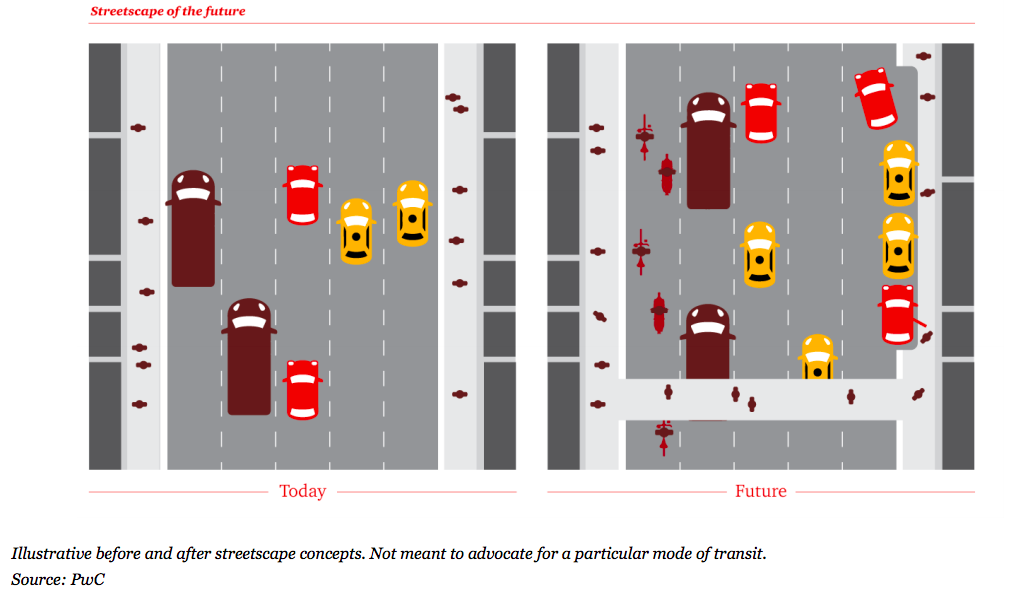NATIONAL PARKING ASSOCIATION (NPA)
Research by PwC
Executive Summary
At the conclusion of World War II, the U.S. began a period of substantial economic and population growth—increasing from 151 million people in 1950 to 326 million people in 20181 . The suburbs were created, urban sprawl increased, and U.S. car culture was born. Over time, these trends accelerated, car ownership increased, and the interstate was created. A whole new way of living emerged—but one significant downside was congestion.
Since this time, household car ownership has increased, exceeding the rate of population growth. Eighty-five percent of commuters still drive or carpool to work, a trend that has remained consistent for the last forty years. With the U.S. population projected to hit 390 million by 2050, the implications of continued growth for congestion are more urgent than ever.
Today, the cost of congestion in the U.S. is $230-$300 billion each year. This includes direct costs such as lost time and indirect costs such as increased cost of goods and services. Congestion costs about four times the amount the country spends on public transit and double its spending on roads and highways.
In 2017, the average person spent 41 hours in congestion, an increase of 8% over 20105. In major U.S. cities, the situation is even worse. In Los Angeles and New York, time spent in traffic is more than twice the national average.
Congestion is likely to worsen in the short to mid-term, fueled by six main drivers.
Macroeconomic conditions. Vehicle miles traveled (VMT) are directly correlated to economic growth. VMT is expected to grow by 14% from 2017 to 2030, driven by an expected growth in gross domestic product (GDP).
Urbanization. The U.S. population is growing and shifting from rural to urban areas. Eighty-one percent of the population lived in urban areas in 2010, and that is expected to rise to 85% in 2030.
Transportation network company (TNC) growth. Ride-hailing has grown substantially and is inducing demand for transportation, shifting demand from public transit which is putting more cars on the street and contributing to congestion at the curb.
E-commerce growth. Deliveries are increasing, and they’re not reducing private-vehicle use (such as driving to shopping malls) as much as was once expected. E-commerce is on a rapid growth trajectory, rising from 0.3% of retail spending in 1998 to 8.7% in 2014.
Infrastructure underinvestment. U.S. public infrastructure was awarded a grade of D+ by the American Society of Civil Engineers (ASCE) and requires significant investment to be on par with that of other developed nations9. The federal gasoline tax, which funds a great deal of transportation infrastructure expenditures, has not been raised since 1993.
Policy and program development. Current policies and programs have had mixed success in reducing congestion, with many leading to unintended consequences that can actually increase congestion.
In the longer term, fully autonomous vehicles (those categorized as attaining “Level 5” autonomy in the Society of Automotive Engineers’ classification system) will be radically disruptive, but may not provide congestion relief. In fact, congestion may worsen due to induced demand from lower transportation costs and a decrease in public transportation ridership. In any case, Level 5 autonomous vehicles are unlikely to arrive en masse before 2030.
Policymakers have a wide range of near-and long-term demand and supply levers to mitigate congestion. These can take the form of policy changes, infrastructure investment, new technologies and economic incentives and disincentives. Specifically, tools available to cities include bus lanes, bike lanes, scooter programs, public transit, new roads and highways, parking policies and pricing, TNC restrictions, transportation demand management programs, smart city technologies, platooning, delivery drones, and Hyperloop. None of these levers can fix congestion on its own, and pulling too hard on one may exacerbate other issues. And this list is far from exhaustive. One solution that hasn’t received adequate attention is parking.
Although its congestion-fighting potential hasn’t always been recognized, parking is important to the smooth functioning of a city’s transportation ecosystem. When there isn’t the right type or amount, or its prices aren’t appropriately set on the street, travelers have more incentive to circle, cars clog streets looking for elusive spaces, and delivery trucks, taxis, and TNC vehicles cause chaos at the curb. Parking can be an effective tool to declutter roads and reduce curb congestion. Here are a few examples of parking-related levers cities can use to reduce congestion:
- Repurpose or reprice on-street parking. The space could be reused to add an additional traffic lane or create a drop-off point for TNCs or delivery companies, which should reduce circling.
- Reduce or eliminate parking minimums. Allow market demand to determine the appropriate supply of parking. This will reduce the cost of development and result in a better balance of parking supply and expected demand for the specific real estate application.
- Explore new smart parking technologies. These can make payments easier, improve navigation, and make prices more transparent, all of which may reduce congestion and emissions.
- Reconsider or reprice double parking fines. Reconsider any arrangements made with delivery services providers and others that allow them to reduce or avoid fines for certain parking violations. Enforce current regulations.
- Leveraging parking as a “curb extension” or mobility hub. Parking could potentially be used in new innovative ways to mitigate congestion, mainly at the curb. A few ways that parking can be leveraged as a “curb extension” include serving as short term parking for TNCs, dynamic taxi or ride-hail stands, drop-off or pick-up points for packages, or mobility hubs for shared bikes, scooters, and vehicles.
Congestion is complex and policymakers face many challenges related to congestion. We propose five guiding principles when making congestion related choices:
- Consider near- and long-term supply and demand levers. A combination of supply and demand, as well as near- and long-term policies are required to drive sustainable change. Near-term solutions are quicker and cheaper to implement, meanwhile infrastructure investments, like bus, rapid transit, and lane expansion require investment over a long period of time.
- Take an ecosystem view to drive city livability. Livability is an important consideration for cities that prize innovation and hope to compete globally for talent and investment. A holistic view is required to solve the complex challenge of congestion; no single tool can fix the problem alone. This requires developing city plans that integrate multiple levers (e.g., public transit, private vehicles, parking) and consider the tradeoffs associated with each action.
- Foster innovation through collaboration, pilots, and agile policy making. Innovation in the transportation space is evolving at a rapid pace. The effects of new technologies and new transit are unproven and often unknown. The development of these new technologies often requires cities to experiment through pilots. This allows both parties to learn and potentially benefit without jumping in headfirst. Public-private partnerships (P3s) can be a valuable tool for cities.
- Develop a financing plan. As demonstrated above, there is no shortage of options to combat congestion at cities’ disposal. But many of them are potentially quite expensive, especially those that involve construction of new roads or bridges or expansion of public transit networks. A sound strategy to pay for such investments is critical to executing successful programs.
- Learn from other cities of similar archetype. Cities will learn the most from peers with similar history, built environment, and transportation infrastructure usage patterns. We provide a framework to categorize global cities into seven different models (Multimodal Core, Walking Core, Urban Hub Community, Mixed Hub Community, Suburban Hub Community, Driving Metropolis, and Efficient Metropolis) and examine case studies of exemplars of several different types, including New York, Chicago, Los Angeles, San Francisco, and Washington in the U.S. and Toronto, London, Singapore, and Paris internationally.
Congestion in the U.S. is all but certain to get worse before it gets better. The goal of this report is to provide analytical insights on the data, trends, innovations, and case studies available to inform public and private plans to reduce congestion.
Download full version (PDF): An Ecosystem Approach to Reducing Congestion
Download (PDF): Congestion Myths vs. Reality
About the National Parking Association (NPA):
https://weareparking.org
The National Parking Association (NPA)’s mission is to serve as the market leader in parking industry research, education and programs that advance the industry and its professionals. Founded in 1951, NPA has more than 2,500 members and represents all facets of the parking industry. NPA is a 501 (c) 6 non profit trade association, based in Washington, D.C.
About PwC
www.pwc.com
PwC’s professional services, including audit and assurance, tax and consulting, cover such areas as cybersecurity and privacy, human resources, deals and forensics. We help resolve complex issues and identify opportunities across these industries.
Tags: ecosystem, National Parking Association, NPA, Parking, PricewaterhouseCoopers, PwC, transportation








 RSS Feed
RSS Feed